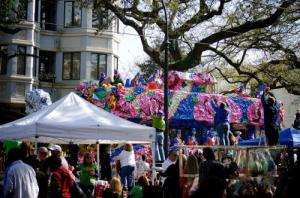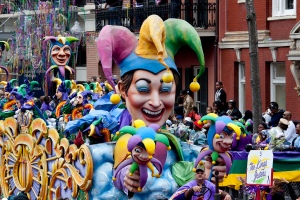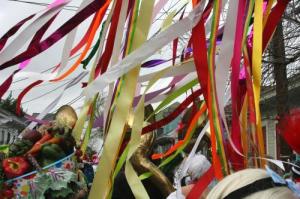Here we are. It’s almost March. And next Tuesday is Mardi Gras! As someone who lived in New Orleans for 4 years while attending college I take great pride in the one of the great festivals/celebrations that New Orleans is famous for.
Most of the rest of my blog here comes from the Mardi New Orleans website.
The origins of Mardi Gras can be traced to medieval Europe, passing through Rome and Venice in the 17th and 18th centuries to the French House of the Bourbons. From here, the traditional revelry of “Boeuf Gras,” or fatted calf, followed France to her colonies.
On March 2, 1699, French-Canadian explorer Jean Baptiste Le Moyne Sieur de Bienville arrived at a plot of ground 60 miles directly south of New Orleans, and named it “Pointe du Mardi Gras” when his men realized it was the eve of the festive holiday. Bienville also established “Fort Louis de la Louisiane” (which is now Mobile) in 1702. In 1703, the tiny settlement of Fort Louis de la Mobile celebrated America’s very first Mardi Gras.
In 1704, Mobile established a secret society (Masque de la Mobile), similar to those that form our current Mardi Gras krewes. It lasted until 1709. In 1710, the “Boeuf Gras Society” was formed and paraded from 1711 through 1861. The procession was held with a huge bull’s head pushed alone on wheels by 16 men. Later, Rex would parade with an actual bull, draped in white and signaling the coming Lenten meat fast. This occurred on Fat Tuesday.
New Orleans was established in 1718 by Bienville. By the 1730s, Mardi Gras was celebrated openly in New Orleans, but not with the parades we know today. In the early 1740s, Louisiana’s governor, the Marquis de Vaudreuil, established elegant society balls, which became the model for the New Orleans Mardi Gras balls of today.
The earliest reference to Mardi Gras “Carnival” appears in a 1781 report to the Spanish colonial governing body. That year, the Perseverance Benevolent & Mutual Aid Association was the first of hundreds of clubs and carnival organizations formed in New Orleans.
By the late 1830s, New Orleans held street processions of maskers with carriages and horseback riders to celebrate Mardi Gras. Dazzling gaslight torches, or “flambeaux,” lit the way for the krewe’s members and lent each event an exciting air of romance and festivity. In 1856, six young Mobile natives formed the Mistick Krewe of Comus, invoking John Milton’s hero Comus to represent their organization. Comus brought magic and mystery to New Orleans with dazzling floats (known as tableaux cars) and masked balls. Krewe members remained anonymous, and to this day, Comus still rides!
In 1870, Mardi Gras’ second Krewe, the Twelfth Night Revelers, was formed. This is also the first recorded account of Mardi Gras “throws.”
Newspapers began to announce Mardi Gras events in advance, and they even printed “Carnival Edition” lithographs of parades’ fantastic float designs (after they rolled, of course – themes and floats were always carefully guarded before the procession). At first, these reproductions were small, and details could not be clearly seen. But beginning in 1886 with Proteus’ parade “Visions of Other Worlds,” these chromolithographs could be produced in full, saturated color, doing justice to the float and costume designs of Carlotta Bonnecase, Charles Briton and B.A. Wikstrom. Each of these designers’ work was brought to life by talented Parisian paper-mache’ artist Georges Soulie’, who for 40 years was responsible for creating all of Carnival’s floats and processional outfits.
1872 was the year that a group of businessmen invented a King of Carnival, Rex, to preside over the first daytime parade. To honor the visiting Russian Grand Duke Alexis Romanoff, the businessmen introduced Romanoff’s family colors of purple, green and gold as Carnival’s official colors. Purple stands for justice; gold for power; and green for faith. This was also the Mardi Gras season that Carnival’s improbable anthem, “If Ever I Cease to Love,” was cemented, due in part to the Duke’s fondness for the tune.
The following year, floats began to be constructed entirely in New Orleans instead of France, culminating with Comus’ magnificent “The Missing Links to Darwin’s Origin of Species,” in which exotic paper-mache’ animal costumes served as the basis for Comus to mock both Darwin’s theory and local officials, including Governor Henry Warmoth. In 1875, Governor Warmoth signed the “Mardi Gras Act,” making Fat Tuesday a legal holiday in Louisiana, which it still is.
Like Comus and the Twelfth Night Revelers, most Mardi Gras krewes today developed from private social clubs with restrictive membership policies. Since all of these parade organizations are completely funded by their members, New Orleanians call it the “Greatest Free Show on Earth!”
Mardi Gras Traditions
Mardi Gras is about music, parades, picnics, floats and excitement. It’s one big holiday in New Orleans!
Everyone is wearing purple, green, and gold, and adorned with long beads caught from the beautiful floats. You’ll see a lot of crazy costumes, kids everywhere, and both locals and visitors having a great time. People sit on the ground, throw balls, play music, eat great food and watch the crowds walk by between parades. During Mardi Gras, all of the businesses and roads are practically shut down. People walk everywhere and meet new friends.  Parades are a major part of celebrating Mardi Gras, and what’s a parade without some really great floats? Ever since krewes began parading through New Orleans over 100 years ago, parade floats have played a major role in Mardi Gras history.Some floats are elaborate and beautiful, while others are funny and satirical. Many krewes have a theme to their parade each year, and so floats are created to reflect those themes. Thousands of dollars are poured into making these floats, and they’re not made overnight. Krewes work on these creations year-round, often at secret “dens” around the city. We’re not exaggerating when we say krewes take their floats seriously.On parade day, dozens of krewe members will ride on the floats, tossing beads and home made “throws” to cheering crowds. Seeing what the krewes come up with each year is never boring, and makes each parade as exciting as the next.
Parades are a major part of celebrating Mardi Gras, and what’s a parade without some really great floats? Ever since krewes began parading through New Orleans over 100 years ago, parade floats have played a major role in Mardi Gras history.Some floats are elaborate and beautiful, while others are funny and satirical. Many krewes have a theme to their parade each year, and so floats are created to reflect those themes. Thousands of dollars are poured into making these floats, and they’re not made overnight. Krewes work on these creations year-round, often at secret “dens” around the city. We’re not exaggerating when we say krewes take their floats seriously.On parade day, dozens of krewe members will ride on the floats, tossing beads and home made “throws” to cheering crowds. Seeing what the krewes come up with each year is never boring, and makes each parade as exciting as the next.
Krewes
Each Mardi Gras Parade Krewe has a unique history and theme. Some have been around for decades, while others have been in existence for just a few years.
Featured Parade Krewes
- Krewe of ZULU – Home page of the Zulu Social Aid & Pleasure Club, well-known for its interesting history and “golden nugget” (coconut) parade throws.
- Krewe of Bacchus – Krewe of Bacchus features national celebrity monarchs each year, and draws hundreds of thousands of visitors.
- Krewe of Rex – This parade krewe is the origin of many traditions of Mardi Gras, including the Carnival colors of purple, green and gold, as well as the collectible doubloon coins (introduced by Rex in 1960).
- Krewe of Endymion – Endymion quickly emerged as one of Carnival’s ‘Super-Krewes’ in 1974 with the inclusion of more floats and celebrity guests.
King Cakes are a vibrant part of the Mardi Gras tradition in New Orleans. As part of New Orleans’s Christian faith, the coming of the wise men bearing gifts to the Christ Child is celebrated twelve days after Christmas. We refer to this as the Feast of the Epiphany, or Little Christmas on the Twelfth Night. This is a time of celebration, exchanging gifts and feasting. Today, the tradition continues as people all over the world gather for festive Twelfth Night celebrations. A popular custom was and still is the baking of a special cake in honor of the three kings, called “A King’s Cake.”
Inside every king cake is a tiny baby (generally plastic now, but sometimes this baby might be made of porcelain or even gold). The tradition of having King Cake Parties has evolved over time, and the person who receives the slice of cake with the baby is asked to continue the festivities by hosting the next King Cake party.
Originally, king cakes were a simple ring of dough with a small amount of decoration. Today’s king cakes are much more festive. After the rich Danish dough is braided and baked, the “baby” is inserted. The top of the ring or oval cake is then covered with delicious sugar toppings in the traditional Mardi Gras colors of purple, green and gold.
In more recent years, some bakeries have been creative with stuffing and topping their cakes with different flavors of cream cheese and fruit fillings.Jan. 6, the Twelfth Night after Christmas, is the day our Mardi Gras season, hence king cake season, begins. Mardi Gras Day, also known as Fat Tuesday, is always 47 days prior to Easter Sunday (the day before Ash Wednesday).
So, in Louisiana especially, Mardi Gras and King Cakes go hand in hand, and literally hundreds of thousands of king cakes consumed at parties, offices and in homes every year. Watch how King Cake is made here.
Mardi gras traditional anthems and great performers of the past.
Follow this link for a classic Mardi Gras medley .
I put together a Rhapsody playlist of the following songs. You can load it into Rhapsody if you’re a member or you can sign up for a free month trial.
- Professor Longhair “Go to the Mardi Gras”. There are many different versions of this song: Fess himself even cut an earlier version called “Mardi Gras In New Orleans.” This is the one you want, however, the king of all Mardi Gras songs, the one with the breathtaking piano intro, the impossibly realized whistling solo, and God’s own shuffle beat. This song actually sounds like a parade coming down your street, which may be why, for locals, it’s completely impossible to imagine Mardi Gras without it.
- The Meters – “Hey Pocky Way”. The strongest of several Mardi Gras classics by these masters of funk during their mid-’70s period. With a microscopically accurate second-line beat, boogie-woogie piano New Orleans style, semi-nonsensical lyrics, and loads of thick funk on top, this sums up the bohemian essence of the celebration. In fact, this adaptation of a traditional parade chant is so infectious in its joy, it’s hard not to grin while listening to it.
- Earl King “Street Parade”. You may know blues guitarist King from his 1962 hit “Trick Bag,” or from his vocal on Professor Longhair’s “Big Chief,” but his career stretches out far before and after that; in fact, the LP of the same name is widely considered one of the great funk albums of all time, and not just because the Meters are there as back up, either. Not as well known as the other songs on this list, this track nevertheless manages to capture the loose feel of a second-line better than any other.
- Al Johnson “Carnival Time”. Even in New Orleans itself, Al’s only known for this one song, which, like many on this list, feature the deathless piano of Professor Longhair. But it’s such a fine testimony to the season’s debauchery, not to mention a snapshot of a Claiborne Avenue scene destroyed by the Interstate highway system, that this one hit was all he needed to sustain a decades-long career: to this day, he bills himself as Al “Carnival Time” Johnson. This prime slice of Crescent City rock is just that hot.
- Sugar Boy Crawford and his Cane Cutters “Jock-A-Moe”. You’ve no doubt already heard countless variations on the standard “Iko Iko” — more than likely the hit ’60s version by the Dixie Cups, which has been featured in several movies. That was bubblegum, however; this is what the song originally sounded like in the decade preceding it. Raw Fifties R&B that effortlessly skips back and forth between a parade-style rhumba and a hot jump blues, it’s also a field guide to the kind of (once violent) street warfare the Mardi Gras Indians tribes practice.
- Professor Longhair “Big Chief, Pt. 2”. The man they call “Fess” was a legend, both inside and out of the city, and during his lifetime he created several timeless classics for the Carnival season. This one is actually the second half of an instrumental, yet with added vocals on the flip (a common practice at the time; Earl King handles the lead here). Fess’ playing defines New Orleans’ piano, and the lyrics are the best recorded tribute to the rich Mardi Gras Indian subculture — a whole article in itself, and then some.
- Rebirth Brass Bank “Do Whatcha Wanna Pt.3”. Okay, this mid-Nineties cut is not an oldie per se, but Rebirth’s take on traditional jazz is timeless anyway, and certainly emblematic of the city’s rich brass-band tradition. This isn’t Dixieland, though (and, despite what they tell you, most New Orleanians don’t celebrate with that anyway); it’s street funk done with trad-jazz elements. And it smokes with the fire of a dozen street battles. Few people can resist the urge to shake… well, the song will let you know.
- The Meters “They All Ask’d For You”. The Meters are responsible for three items on this list, all dating from the city’s fertile early ’70s homegrown funk period. This rather silly song has nothing lyrically to do with Mardi Gras — it’s practically a children’s song, when you get down to it — but the orchestration and especially the beat make it a perfect soundtrack to strutting down the street, and it’s therefore become much beloved by the locals. Also features authentic (that is, technically incorrect English) dialect.
- The Hawkettes “Mardi Gras Mambo”. New Orleans is small as metropolises go, which is why so many of the songs on this list share musicians, vocalists, and songwriters. In fact, this high school group — which recorded the original version of this classic in the Fifties — would go on to mutate into the Neville Brothers. As a mambo, this isn’t one; as a living distillation of the holiday’s ethic, it’s undeniable. The lyrics are great, too: “Down in New Orleans where the blues was born, it takes a cool cat to blow a horn.” True.
- Stop Inc. “Second Line”. To “second line” is to march/dance in a certain fashion during a Mardi Gras parade. (If you’re actually a part of the parade, you’re the first line; if you’re just drunk and dancing behind it, you’re in the second line.) Indeed, the march and the song are synonymous, and go back decades. When, in the ’70s, it was discovered that there were no existing recordings of the song, a group of session musicians stepped in and produced this, the most popular recording to date of this brass-band standard.
Now what kind of beer goes best with Mardi Gras? Well. When in New Orleans, go with the local brews. The 2 most commons beers in New Orleans are Dixie Beer and Abita.
Cheers!!





Pingback: Carnival on the Coast in Biloxi Missippi 2014 for Mardi Gras | Vino Con Vista Italy Travel Guides and Events